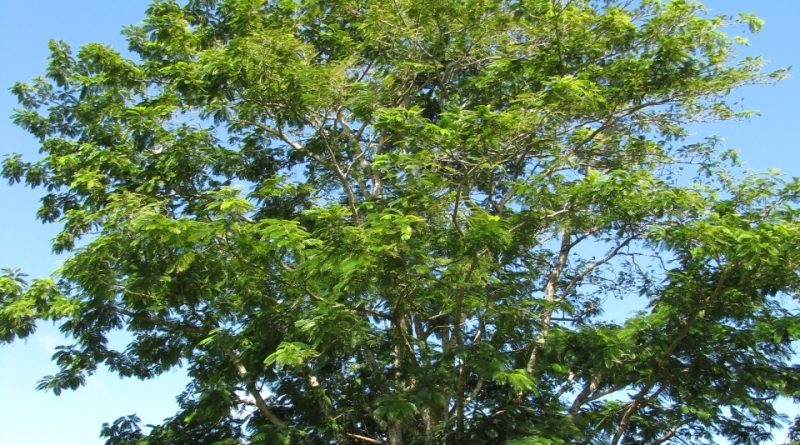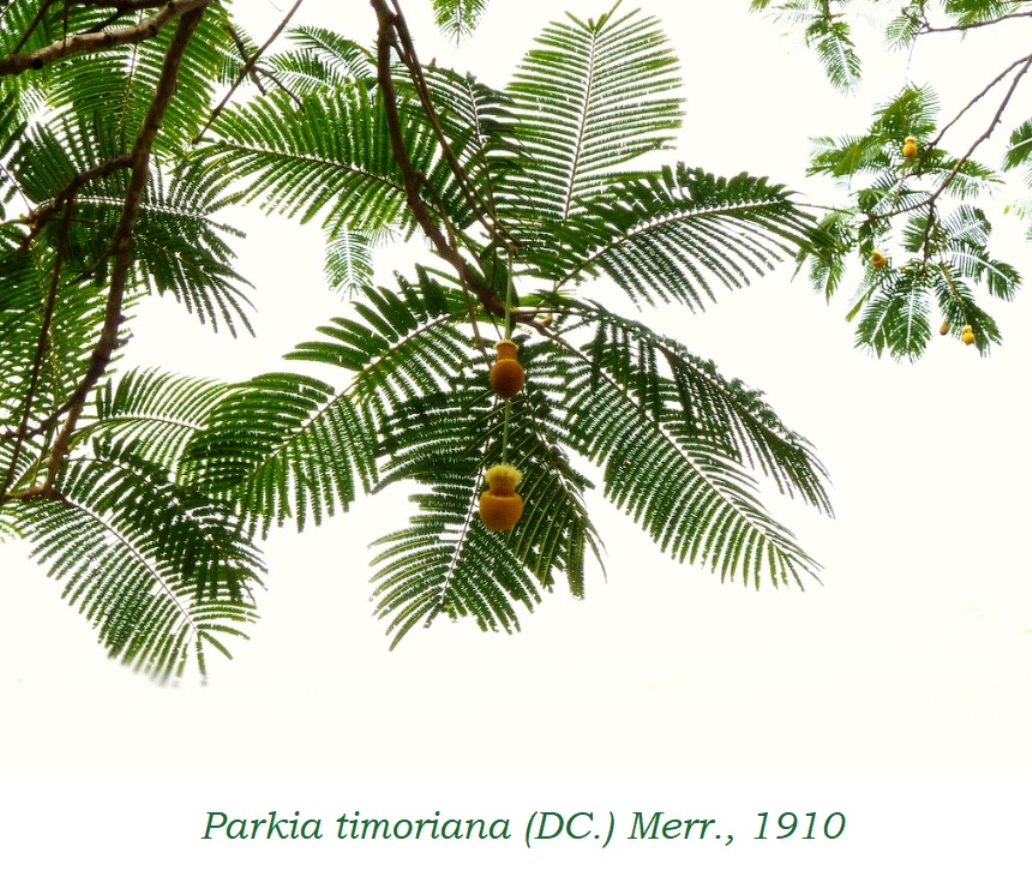Parkia timoriana
Parkia timoriana
The bean tree (Parkia timoriana (DC.) Merr., 1910) is an arboreal species belonging to the Mimosaceae family.
Systematics –
From a systematic point of view it belongs to:
Eukaryota domain,
Kingdom Plantae,
Subkingdom Tracheobionta,
Spermatophyta superdivision,
Magnoliophyta division,
Class Magnoliopsida,
Subclass Rosidae,
Fabales Order,
Mimosaceae family,
Genus Parkia,
P. timoriana species.
The term is basionym:
– Inga timoriana DC..
The terms are synonyms:
– Acacia niopo Litv.;
– Mimosa biglobosa Roxb.;
– Mimosa peregrina Blanco;
– Parkia biglobosa Benth.;
– Parkia brunonis Graham;
– Parkia calcarata Gagnep.;
– Parkia calcarata Lecomte;
– Parkia grandis Hassk.;
– Parkia roxburghii G.Don;
– Parkia roxburgii G.Don.
Geographic Distribution and Habitat –
Parkia timoriana is a plant native to Assam in India, Indonesia, Malaysia, Myanmar and Thailand and widespread in India, Bangladesh, Myanmar, Thailand, Malaysia, Indonesia and New Guinea.
Its habitat is that of humid forests, mainly from sea level to about 600 m of altitude.
Etymology –
The term Parkia is in honor of the Scottish physician and explorer Mungo Park (1771-1806).
The specific Timorian epithet refers to one of the places of origin, and in particular to the island of Timor.
Description –
The Parkia timoriana is a tree, partly deciduous, which grows up to 30 m in height and more.
The trunk is cylindrical, up to about 80 cm in diameter and often has buttresses at the base which can be 1 to 4 meters high and extend 1 to 2 meters or more outwards and the bark is greyish brown.
The leaves are bipinnate, alternate, 30-50 cm long with 20-30 pairs of pinnate leaflets, 9-12 cm long, each with 50-70 pairs of opposite leaflets, close together, linear oblong to sigmoid with pointed apex, 5 -10 mm and 1-2 mm wide.
The flowers are small, with 10 filamentous stamens, longer than the calyx, they are gathered in inflorescences of 3-4 cm in diameter, pedunculated, pendulous.
It reproduces by cross-pollination by nectarivorous bats of the species Eonycteris spelaea.
The fruit is a linear, flat legume, 20-36 cm long and 3-4,5 cm broad, glabrous, containing 13-20 ovoid black seeds of about 2 cm long.
Cultivation –
Parkia timoriana is a tree that is harvested from the wild and used topically as a source of medicines, hair shampoos and food.
This tree is typical of lowland rainforest, mixed deciduous and dry evergreen forests where it grows at elevations from sea level up to 600 metres, occasionally rising up to 1,300 metres.
The plant is pollinated by bats and prefers fertile soils with a pH between 5 and 7.
It is a very common plant in the area of origin, of fast growth, with undoubted ornamental characteristics due to the elegant foliage and the curious inflorescences.
This species is employed in the tropical and subtropical climate zones as shade tree in parks and gardens and along the roadsides, but also in the coffee plantations, and in the reforestation and for the control of the erosion.
The tree requires full sun and is not particular about the soil, even if poor; well-rooted plants can tolerate short periods of drought.
The plant reproduces almost exclusively by seed, as the cuttings have a low rooting percentage; the seed must be previously scarified and immersed in water for 1-2 days; it should then be placed in an organic and sandy substratum, kept humid at a temperature of 24-26 °C. In these conditions, germination times are 2-6 weeks.
Customs and Traditions –
Parkia Timiana is a plant known by various common names; among these we report: buah patar, petai hutan and timbarayong (Borneo), yongchak (Manipur, India), kariang, nitta tree and riang (Thailand), kedawung and peundung (Java), alai (Sumatra), petai kerayong, batai hutan, kedaung and kupang (Malaysia), kupang and amarang (Philippines), tree bean (English language), khorial (Assam) mai-karien (Myanmar).
This tree is used for various purposes in Thailand and Indonesia. In Thai cuisine the sprouts are known as nitta sprouts and are added to curries. When the seeds are ripe, they have a hard, black coating. The seeds can be dried and stored. The seeds have a strong sulfur odor, due to the presence of thioproline. In some areas, the seeds of the similar tree species (Parkia speciosa) also known as yongchaak, petai or stink beans are much more popular, and its beans are consumed as a second choice. However, some find the aroma and flavor of these seeds so attractive that they consider them a delicacy.
The products of this tree are consumed in numerous regions. Its long pods are eaten and can be mixed into a salad or chutney.
Wood is also used which is of reasonable quality; it is used for carpentry, furniture, interior finishing, cash registers, and in the paper industry, as well as as a fuel.
Wood is in fact used for fire and for construction.
However, in Africa wood is not used, but the tree is planted to decorate parks. It is a popular garden tree in India, particularly in Assam, where it is a common feature in Meitei courtyards.
As for agroforestry uses, the tree is sometimes grown to provide shade on coffee plantations and nurseries.
Regarding nitrogen fixation there are conflicting reports as to whether or not this tree has a symbiotic relationship with certain soil bacteria.
The tree is vulnerable to the Cadra cautellalla butterfly. The larva penetrates the seeds to spend its pupal period, feeding on the inside and filling them with its silk. It can also feed on flower buds.
Preparation Method –
Parkia Timiana is a plant that has a certain importance in its areas of origin.
Green legumes are consumed as vegetables and sold in markets, even the seeds are edible, raw, boiled or toasted. The species then occupies an important place in the traditional medicine of South East Asian countries, the leaves and bark are used in skin infections, the seeds toasted and powdered for various pathologies.
The wood is used in carpentry and as fuel.
Among the edible uses, seeds are used in particular; these are cooked.
The hard, black seeds are eaten raw or dried and preserved.
Germinated seeds are also consumed.
In the medicinal field, the seeds are considered beneficial in the treatment of hepatalgia, edema, nephritis, diabetes and colic, probably due to their diuretic and relaxing activity.
They are also used as anthelmintics.
The ripe seeds, toasted and powdered, can be ingested as a medicine against colic, flatulence and stomach ache, or they can be used in remedies against cholera or menstrual cramps.
The powdered seeds are applied externally to wounds, ulcers and abdomen to relieve pain.
The leaves can be ground as an ingredient in a colic remedy.
The leaves and/or bark are applied topically to clean wounds and ulcers and as a treatment for scabies.
The bark is used externally as a treatment for scabies, boils and abscesses.
Among other uses, the pods, crushed with water, are used as hair shampoo.
Guido Bissanti
Sources
– Acta Plantarum – Flora of the Italian Regions.
– Wikipedia, the free encyclopedia.
– GBIF, the Global Biodiversity Information Facility.
– Useful Tropical Plants Database.
– Conti F., Abbate G., Alessandrini A., Blasi C. (ed.), 2005. An annotated checklist of the Italian vascular flora, Palombi Editore.
– Pignatti S., 1982. Flora d’Italia, Edagricole, Bologna.
– Treben M., 2000. Health from the Lord’s Pharmacy, Advice and experiences with medicinal herbs, Ennsthaler Editore.
Photo source:
– https://tropical.theferns.info/image.php?id=Parkia+timoriana#plantimages/3/1/31c07848e7092fb48efa18787abb51e3f112406e.jpg
Attention: The pharmaceutical applications and alimurgical uses are indicated for informational purposes only, they do not in any way represent a medical prescription; we therefore decline all responsibility for their use for curative, aesthetic or food purposes.


